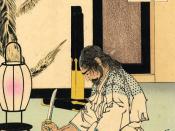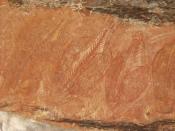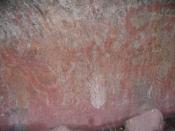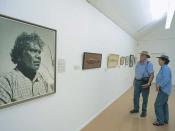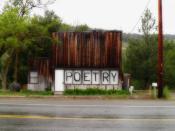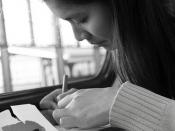This book, entitled "Prayer for the 21st Century", is by famous Australian writer, John Marsden. It is an illustrated, poetic ballad, filled with metaphors and complex issues, written to send messages of hope and warning intended for the people of this new century, especially those that will shape it (our children), about the lessons learnt from the past, the importance of today, and the wonders of the future.
The font of the text on the front cover, and throughout the book for that matter, is in an untidy scrawl that is both important - in that it is in a bold font and is a demanding colour (either black or white) - and is informal, imperfect, personal and human - in that it is handwritten. These aspects combine to show the picture-book nature of the book; that the text is really part of the art in the illustrations themselves, and that the two cannot be isolated on their own and singled out as visual or written text. This motif is continued throughout the book.
The front cover of this book has a spray-patterned, blue background, which has calm connotations. The blue also serves the purpose of increasing the salience of the bright orange picture of the boy in front of it, because the picture contrasts violently with the background, and reducing that of the soft green lines of scrawled writing that fade into the blue of the background (the writing in the background is another example of where the line between visual and written text is unclear). The boy is the clear focal point of the page, and stands out from the rest of the cover, making the lines of the poem hardly noticeable in comparison. This is to make the point that words, like those in the poem, are not nearly as strong as actions - especially the actions of those who, like the child on the cover, will shape the 21st century.
The title page has an earthy coloured, frond-patterned background with two hand prints surrounding the text of the title and author's name. These handprints have aboriginal connotations, and seem to hold some sort of wisdom from past ages. These visual elements combine with the lines in the text to reveal the nature of the poem; that this is not truly a prayer to a god, but a command, request, and message of hope for this new generation. It is a culmination of wisdom from the past centuries, for this new century, and a reminder to the newer generations to remember the lessons of the past.
"May the road be free for the journey." These words make up the first line of the poem and introduce us to the first idea of the poem, that life must be free. The idea of freedom being the main message in this first line is emphasised by the word "free" in large, lowercase font, placed directly above the line of the poem. This is a motif effective at showing the main point of the page, and is repeated throughout the book (the main idea being emphasised by a large fronted keyword place in the background) which is effective in emphasizing the main idea in the text. The background is a gravel-brown colour, emphasising the comparison of life to a dirt road, a free road, a road that could lead anywhere.
The picture on the left page continues this idea of an unknown future, by comparing life itself to a river, natural laws to banks, and the individual as someone travelling along a river in a boat. In this stream of life, no one knows what is around the next bend, except that around one of them, eventually, is the sea (death). The picture also continues the theme of abstract metaphors and symbolism, in that the picture is not really boats, just freehand drawings of them. However, whether life is a road or river, the point remains, it must be free.
The next page has a very similar layout to the page before it; and indeed to every page in the book, with a line of text, a textured background, and a picture (sometimes more than one) upon a double page spread. The text on this page, "May it lead where it promised it would", makes the point that life must deliver the reward it offers. The blue in the background of the second page is associated with hope and promise, and this promising blue is again used in the illustration. In the illustration, is a Queen, symbolising success and all of the glory that was promised to come with it. The theme of promised success and the associated rewards that come as a result is continued in the picture of the map - which appears to be from a time of discovery and conquest of new lands. The various scientific diagrams are there in order to make the point that there will be an answer to all of our questions if we work hard, further emphasising the idea of effort leading to the much deserved and promised success.
Upon the set of pages, two lines instead of one are written. These are; "May the stars that gave ancient bearings Be seen, still be understood." These lines urge people to remember the knowledge of the past, and be able to understand it. The picture itself is easy to link to the line (it is a picture of stars) however, due to the fact that it is done in the Aboriginal style, the picture's full meaning cannot be understood, except by someone whom knows how to interpret and understand the ancient symbolism of Aboriginal art. This introduces the idea that, for the knowledge of the past to be fully realised, it must be understood.
The next page now returns to the idea of life as a journey, by calling the individual a traveller, introducing the concept that life should be safe for all, and that the "safe" people must find those whom have been lost, and help those whom have been forgotten. It does this in the lines, "May every aircraft fly safely, May every traveller be found," The concept of safety in life is emphasised by the colour of the background; a calm, soft green. In the illustration, the audience is placed in the point of view of someone inside of a safe aircraft, who is looking out of the window. Directly outside of the window, the sky is a serene blue; but around the window's red, orange, and yellow - colours with "danger" connotations - edges, another scene forms. A lonely traveller, who could be anyone due to its ambiguous colour and unknown gender, stands lost and alone, unsafe and helpless upon the aircraft's wing; surrounded by a dark sky with the only hope of help being from the person in the plane, who is the viewer of the picture. This calls upon the viewer, as a traveller of life safely within the walls of the aircraft, to help the lost person, to find the traveller; and puts the viewer in the spotlight, making the point that; if you won't, who will?Upon the next page, the two lines read; "May sailors in crossing the ocean Not hear the cries of the drowned." The same layout as before is used, except on this page, two pictures instead of one, are used. The background is blue, which has links to tears ("cries"), feeling "blue", the ocean, and the uniform of a sailor. The first picture appears to be a symbolic representation of someone battling against life's troubles (i.e. a sailor crossing the ocean), fish call from the sea as spirits of the drowned, the dark sea thrashes and churns, while the yellow sky swirls above a small boat riding the crest of a wave. In the next picture, one of life's traveller's has heard the cries of the drowned, and joined them. However, in the background of this picture, there is land, showing that even at the worst times, there is still hope. In both of these, the idea of the individual travelling the ocean or river of life, in a boat, is reintroduced. The main point made by the last two lines of this stanza, and their corresponding illustrations, is that life has ups and downs, and not to succumb and relinquish one's self to despair at one's lowest points, because, as was stated on the first page, is restated on this page, and is stated again on the last page, no one can know what the future holds.
"May gardens be wild, like jungles, May nature never be tamed," are the first lines in the next stanza of the poem.
The pages have a yellow, earthy-brown, palm-frond-patterned background, which connotates nature and jungles. The picture, with its complete absence of straight lines, and blurred movement, makes the point that nature is never rigid and constrained, but free to do whatever it wishes. This point is reinforced in the bank less waterfalls, and the rounded cliff faces. The people in the picture exist to draw attention to the relationship between nature and people, and says that the people of the 21st century, like those in the picture whom are neither trying to disrupt or control nature, must harmoniously co-exist with it nature, and not try to tame it, but to acknowledge it's freedom, and grasp the fact that nature is not for humankind to control, but is untameable, it is wild and free.
"May dangers create of us heroes," reads the next line. The background of this page is a splattered, cameo green, which, along with the mateship displayed in the picture, connotates war. However not all heroes are born of violence, as is shown in the midshot (inviting the viewer into the scene) picture of a boy jumping off the top of a haystack, and his friends cheering him on. The black and white photography, setting, and attire of the people in the picture appear to be from an old time, a time of simple values, and simple heroics. At first glance, it appears that the boy in the picture is a hero because he did something that was dangerous, but this is not the case. He is a hero because he made people happy by facing the danger. This goes on to show the true meaning of the line. That we must always have people that go out of their way, or face danger, to help others whom are in need. The boy symbolises that anyone can be a hero. That anyone, and everyone, must help those in need.
"May fears always have names" reads the next line of the poem. The keyword in the background ("fear") is hidden among tendrils of paint, first introducing the concept that, even though the name of the fear may be hidden, it always exists, fears always have names. The illustration is dark, with soft, runny brushstrokes that seem to obscure true meaning. At first, it appears to be a picture of fears, peeping between the trunks and branches of trees, but upon closer inspection, it is revealed that the fears are not fears at all, but people, experiencing that which we fear. The people in the picture are in agony, some cry at the side of a dead loved one, others just cry out in pure pain. Then, finally, the viewer notices a horseman in between the trees and realises two things. The first is the reference to the Myall Creek Massacre and the next was that the fears were created by people, the fears have names, and their name is the evil of humankind. It asks us to remember our evil, and asks the people of this new century not to repeat the evils past committed, or else, like the symbolic dove upon the picture's left, peace will flee the world.
The next page, and its two lines, "May the mountains stand to remind us Of what it means to be young", now talk about the impermanence of youth, and the importance of the wise. There are again two pictures. In the first picture - a firm lined photograph - great mountains, symbolizing the vast importance, knowledge, wisdom and experience of the old, stand in the background with rays of light falling upon them; while in the foreground, a vast plane of rocks, younger, smaller versions of the mountains that dwarf them in comparison, stand to show the true importance of the memories of the old, in comparison to the inexperience of the young. The second picture is a soft lined painting (symbolizing the impermanence of being young) of two youths embracing and in love. They are shown next to a shell, which puts them on a symbolic scale. It makes the point that, if these two youths are dwarfed by a shell, and a shell will be dwarfed by a rock, such as those seen in the picture on the opposite page, how tiny they are, how fleeting their time as youth if they are to grow into the giant mountains, how petty their memories and experiences in comparison to the mountains. It is through this symbolic scale that the illustrations remind us of what it means to be young.
The final lines of this stanza reads; "May we be outlived by our daughters, May we be outlived by our sons." This line is different from the rest of the poem in that its meaning is straightforward and obvious, and that this line is actually a prayer for the long and happy lives of our children. The pictures add to the text, in that they are pictures of people from different ethnic groups, and that they join united at the edge of each picture, showing that it refers to the entire people of the 21st century, they are not our children in a literal sense, but are the children of humanity. It prays that, even though there will be hardships in life, as is mentioned many times before and is symbolised by the black and white colour scheme of the older children, the new generation, as with the generations before them, must live through them, and continue - as is symbolised in yellow colour of the background of the page - to shine on like the sun, outliving those before us.
History's importance is again brought up in the final stanza, with the opening line being: "May the bombs rust away in the bunkers, May the doomsday clock not be rewound," The lines ask the new century not to use mankind's evil, even though they do and always will exist; they then ask humanity not to repeat past mistakes, even though we will always have the potential to. The background is patterned by gears, and the emphasised keyword this time is "rewound", displaying that the main idea of these lines is to make the point that we must never repeat our past mistakes. The gears are also part of the "doomsday clock", which is simply referring to time and history itself. The picture shows text from what appears to be newspaper articles, which refer to injustices throughout history to the indigenous peoples of Australia, which hold some of the greatest evils of this country's history. The many pictures at the top of the image show the faces of the many sufferers of evil, from a small child, to a grown man. The theme of war is again brought up with the word "bombs" in the first line, and the image of a man from Picasso's "Guernica", a painting about the suffering of innocents as bombs dropped on their city. For many people, that day was their doomsday. It once again brings up the issue that humankind itself is what causes people the most pain and suffering. Overall, the pages ask the people of the 21st century never to use humankind's evil again.
The next page continues the theme of war, with a reference to the bombing of Hiroshima and Nagasaki in the Second World War. The line reads "May the solitary scientist working, Remember the holes in the ground" and the single, hand drawn illustration, is of a large and powerful solitary scientist in his own solitary world, admiring and awestruck of his solitary discovery; while behind him his discoveries explode over a desolate plain on which the only survivors are a small, helpless man and woman, silhouetted against the bleak white light thrown across a vast landscape, and upon them from evil inventions that exist to destroy. It asks the people that will shape this new century to remember that every single action has consequences, and that knowledge can just as easily be used for the evil of bombs, as it can be used for the good of curing cancer. It tells people to look into the past, in order to shape the new century's future for the better.
"May the knife remain in the holder, May the bullet stay in the gun," These penultimate lines continue the theme expressed in the first stanza, that even though we have the potential and the means to carry out evil, the people of the 21st Century must never do so. The page is extremely straightforward in relation to the pictures - the bullet is being put into the gun and must remain there and the skeleton has been skinned with a knife - however, in the skeleton picture, the body is made up of many different cut up body parts, making the new point that we should not use evil upon anyone, indiscriminate of who they are, or what they believe in.
The final lines of this prayer are as follows: "May those that live in the shadows Be seen by those in the sun". Upon the pages surrounding these lines, are two pictures, one of footsteps on a beach with a man's shadow crossing their path; the other of a silhouetted man running along a beach with a beam of sunlight floating on the waves of the sea. Both pictures are in black and white, emphasising the ideas of shadows and sun. The blue background is the same textured blue as at the very first page of the poem, and is sea-spray like in appearance. The theme of these final two pages, is very simple, to help others, and this idea can be seen throughout the illustrations. The picture of the footprints, reminds of the Christian story of how Jesus carried the man over the sand, and through life's shadows. This makes the point that, sometimes, others need to be carried through hard times. The shadow crossing the path of the footsteps represents a dark time in the life of the person that made them but this shadowed part is only a mere fraction of the whole, a symbolic representation that life does have deep darkness, but for the most part, it is light.
The next picture across, the one of the runner, continues this idea; and also adds to it. This time, the sea is used s a metaphor for life, and, as first mentioned on the page about sailors, the sea can be in many states. The repetition of the motif of both light and shadows making up life is displayed on the surface of the sea, where the thick beam of light shines and glistens, while at the edges, shadows and darkness can be seen. However, yet again, there is more light in the picture than there is shadow. The illustration of the silhouetted man running along the beach, making his own path in the sand, appears - at first glance - to show that he himself is in a shadowed stage in life. However, on close inspection something appears to be in his arms, if you look very closely, you can see that he is carrying something. This man is not the Christian Messiah; this man is an ordinary person, showing simple, yet powerful heroics as mentioned earlier in this book. He further demonstrates that we all can be heroes, even without obvious physical dangers, just by helping someone. This final line is a hope. It is a hope that maybe, just maybe, in the 21st Century; we can all stand and walk together, in the light of the future.
This simple yet honest poem of hope and fear effectively reached out to, and appealed to me, the target audience and a child of the 21st Century. It was deep and complex in some places, yet simple enough to be understood by the intended reader. It is a thought stimulating read to be understood more and more with wisdom and experience. Now it is just a question, first posed in the photograph of the boy on the front cover - one side of his face in darkness, the other in light - as to whether this generation of young rocks will grow up, remember the past, not repeat its mistakes, and one day be tall mountains. Then we will write a new prayer, for a new century.
By George Harris.
Bibliography:http://www.johnmarsden.com.au/home.htmlhttp://en.wikipedia.org/wiki/John_Marsden_(writer)http://www.judyoz.com/ccp0-display/john-marsden-books-tomorrow-ellie-novels-australian-fiction.htmlhttp://www.fantasticfiction.co.uk/m/john-marsden/
